Download
in PDF Format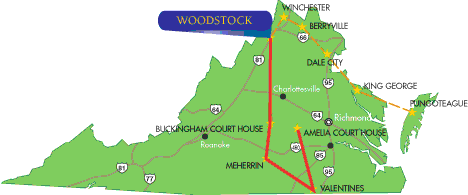
The town of Woodstock anchors the northern Shenandoah
Valley firmly between the waves of Allegheny Mountains to the west, and the
more adventurous Massanutten ridge to the east.
The town’s indecisive neighbor, the fabled North Fork of
the Shenandoah River, swerves dramatically east and west in giant bends on
its reluctant journey north, to lose itself in the Potomac near Front Royal.
The river nudges Woodstock’s town limits, but doesn’t
enter the town proper. And that tenuous relationship seems just fine with
the folks of this historic town. Besides, the town’s residents are quite
focused on the business of simply being Woodstock.
Woodstock has no single industry or business that
dominates its economy. It takes pride in being the county seat for
Shenandoah County, but otherwise concentrates on just being a great place to
live.
One thing about being a great place to live ... people
don’t leave. Carolyn Baker observes, “Best thing about Woodstock and places
like it is that the same people have been here forever ... At least as long
as I’ve been alive,” she smiles. A waitress at the Walton & Smoot Drug Store
lunch counter, Carolyn smiles a lot. She can trot out a sandwich with
remarkable speed, but locals say the counter’s crowning glory is its
milkshake, the old-fashioned kind blended in front of you and served with
the “extra” giant metal cup holding that special second helping.
Walton & Smoot has held a place on Woodstock’s Main
Street for more than a century, although it did move across the street in
1962 for more space. Today the patent medicines in the store are giving way
to gifts and souvenirs, but the pharmacy counter remains busy. Displays of
store history mark the back walls, and a few tables in no-man’s land between
the lunch and pharmacy counters are frequently filled with local folks
exchanging views on the world, acknowledging passersby, or just enjoying a
shake.
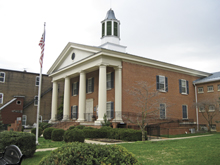
The stone 1795 Shenandoah County Courthouse
stands on Main Street just across Court
Street from the 1975 courthouse (above), and
remains the oldest courthouse in Virginia in
continuous use. |
Walton & Smoot is directly across Main Street from the
historic old Shenandoah County Court House. You have to add that “old” in
describing it, because it stands close beside the “new” Shenandoah County
Court House ... just across Court Street. The older of the two courthouses,
built in 1795, is the oldest courthouse in Virginia still in use. It houses
the General District Court. The new courthouse, built in 1975, holds the
Circuit Court.
There’s a large bust in front of the old courthouse. A
few feet away a statue of the same man is draped in bronze robes that almost
seem to flow with the wind. To understand the double honor paid this man,
you have to know a bit of Woodstock’s history.
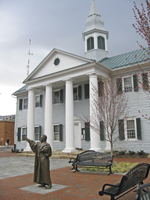
The stone 1795 Shenandoah County Courthouse
(above) stands on Main Street just across
Court Street from the 1975 courthouse, and
remains the oldest courthouse in Virginia in
continuous use. |
In 1752, a German immigrant who had settled temporarily
in Pennsylvania managed to obtain 400 acres of valley land, land now in
Woodstock. Over the next few years, Jacob Miller added to his holdings and
laid out a town. The area was then part of Frederick County, so
he had the area’s member of the House of Burgesses — a
gentleman named George Washington — sponsor legislation creating the town of
Woodstock on his land. The act passed in 1761. Washington may have become
known as the father of his country, but he had a more direct paternal
relationship with Woodstock.
However, the monuments at the courthouse are not of
Washington, nor of Miller.
In 1772, Woodstock became the county seat of the newly
created Shenandoah County. That same year Peter Muhlenberg arrived in town.
A Lutheran pastor later ordained in the Church of England so he could preach
in Virginia’s “Established Church,” the Rev. Mr. Muhlenberg quickly became a
Woodstock community leader ... but not necessarily in a religious sense. He
became an outspoken American patriot and leader of local Revolutionary
discontent.
On Sunday, Jan. 23, 1776, Muhlenberg took his sermon from
Ecclesiastes and its assertion of “a time for war and a time for peace.” He
concluded firmly that “the time for war has come” and, throwing off his
vestments dramatically, stood before the congregation in the uniform of a
Continental soldier. He had placed a drummer boy outside the church to
muster recruits for the army. By the end of the war, the “Fighting Parson”
became a general and commanded all Continental soldiers in Virginia. Today
Woodstock remembers him with the two monuments at the courthouse, with a
street, and with a place on the town seal.
A generation later, the Civil War once more brought
notables to Woodstock. Many of the most famous generals for both the North
and South stayed in the town as the war flowed up and down the Valley. Union
General Phil Sheridan, after destroying Valley farms and crops to deny food
to the South, telegraphed from Woodstock his famous declaration “I have made
the Shenandoah Valley of Virginia so bare that a crow flying over it would
have to carry its knapsack.” Obviously the Valley recovered. Crows no longer
need camping gear.
History Still Key
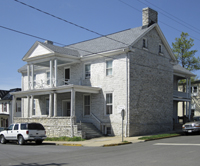
The Woodstock Museum is housed in the
historic 1772 Marshall House. Thomas
Marshall, father of Supreme Court Justice
John Marshall, is said to have rented a room
in this house. |
History remains important in Woodstock today. The
substantial Woodstock Museum, with two buildings a block off Main Street, is
crowded with local relics, and memories.
Barbara
Kesser, the museum’s secretary and owner of Spring
Hollow Antiques downtown, is proud of the collection. “People are impressed
by the museum,” she notes. Most museum artifacts are in the Marshall House,
a house where, it is said, Thomas Marshall, father of the Supreme Court
Justice John Marshall, rented a room while serving as clerk in the nearby
courthouse.
The other part of the museum, the nearby Wickham House,
dates back to just after the Revolutionary War. Kesser notes, “We have it
set up as a home would have been in the early 1800s.” She observes that the
bedroom and kitchen are furnished with the actual furniture that was there
in that house at the time.
Kesser has enjoyed working with the Woodstock Museum for
about 10 years. “I like the history behind things here. They all have a
story to tell,” she says. “I think you can actually read that story in the
wear on furniture, for example.”
Like many in Woodstock, Kesser visited the town, liked it
… and just stayed. She smiles, “We escaped from Southern Maryland about 25
years ago.”
Jean Sherrad, co-owner of the Woodstock Café & Shoppes,
moved from Tennessee. “We came here for the beauty of the area. We visited
when our kids were little, and said we wanted to retire here. And we did.”
Sherrad reports her coffee-and-sandwich shop has
benefited from the influx of new people, a lot from Northern Virginia. “The
shop has really exceeded our expectations. The people here, both the locals
and new people, are different, are willing to try new things.”
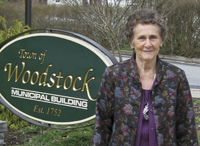
Alma Hottle, Woodstock vice mayor until July
1, has 28 years on Town Council, and spends
her days promoting Woodstock as the only
employee of the town's Chamber of Commerce. |
Alma Hottle is one of the locals. Indeed, she is a local
institution. “I was born here, right down the street,” she says from her
office in the Chamber of Commerce, just across Main Street from the
Woodstock Municipal Building. That proximity is convenient, because Hottle
is winding up 28 years of service on the Woodstock Town Council and a term
as vice mayor.
Looking out her office window, Hottle recalls, “My father
worked right across the street, rebuilding old batteries.” She reflects a
moment. “He was good at it, too. He was offered a better job, but he would
have had to move. He stayed here.”
Hottle too has had opportunities to leave, but hasn’t. “I
like the people here. I like them a lot. I also like the slow pace of time
here.”
Working out of a small office — equipped with a
typewriter, but no computer — Hottle finds promoting her town
straightforward. “Working for the Chamber is easy. Woodstock sells itself.”
Laughing at her age, Hottle boasts she spent 55 years
with the Woodstock Fire Department Auxiliary, “And now my daughter is
president of the fire department.” She smiles, “I’m so old I’m even
president of the museum.
“I’ve seen change,” Hottle admits. “We have more
businesses now, and different businesses.”
Change Means More
County Clerk Denise Barb-Estep agrees that “more” is the
biggest change. “There are more people now, in part because we are so
convenient to Northern Virginia.” Growth in Shenandoah County’s population
over recent decades has prompted expansion of county facilities in
Woodstock. The county is about to build a new facility for the courts now
housed in the “old” courthouse. But the future of the old structure is
uncertain. Apparently the family who originally donated the property for
county use put a stipulation in the deed that, if the courthouse is
abandoned, it must revert to the descendents of the donors, even more than
two centuries later. A decision is expected sometime, but time moves slowly
here.
Woodstock is a true mix of natives and newcomers, and all
seem quite happy to be residents of this historic Shenandoah Valley
community, and willing to share it.
Hottle sums it up for many. “You get to know this
community, you get to belong. When you’re here there are lots of people you
know.
“You’re home.”
|